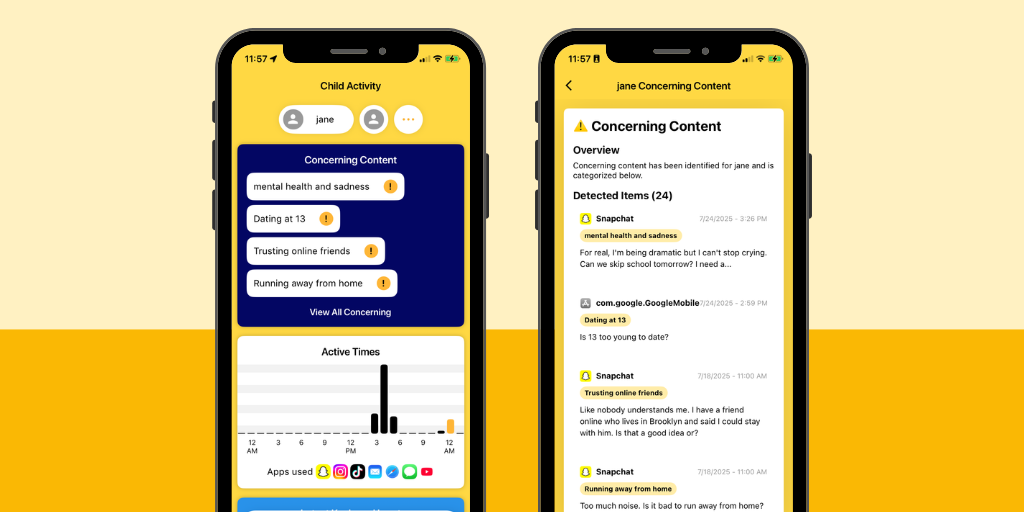
Welcome to Parent Pixels, a parenting newsletter filled with practical advice, news, and resources to support you and your kids in the digital age. This week:
📱 The keyboard that helps you see what your child types across all apps: Kids don’t just chat on one app. They’re messaging on Instagram, searching on Google, and talking to friends on Discord simultaneously and while eating all the food in your fridge. With the new BrightCanary Keyboard, you can monitor typed activity across any app — from Discord to Roblox chats. With AI-powered insights and real-time concerning content alerts, you can stay connected and informed, without reading every word. Plus, you can still monitor text messages and Google + YouTube searches with the BrightCanary app. This feature is available now, and if you currently use BrightCanary, you’ll see an update in the coming weeks. Learn how it works and how to set it up.
😩 Does the number of times teens pick up their phones influence their mood? If you have an iPhone, you can check how often you pick up your smartphone during the day: Go to Settings > Screen Time > See all app and website activity > Pickups. You can even see which apps you checked most often after picking up your phone. That’s interesting (and potentially harrowing, depending on how often you pick up your phone), but how does this impact teens? Researchers studied a group of teens over two weeks and found that teens picked up their phones an average of 112.6 times per day. Nearly half (49%) of pickups were for Snapchat, followed by Instagram (13%) and messages (12%). They also found:
Over at Techno Sapiens, Jacqueline Nessi, PhD, one of the authors on the study, notes that the smartphones didn’t seem to impact the teen’s moods. Rather, kids who look at their phones more often might see things that make them upset, or kids who already have variable emotions use their phones to feel better, among other factors.
If your teen is using their phone to help cope with their emotions, it’s important to pay attention to what type of content they’re consuming. Are they talking to a friend or family member, or are they doomscrolling on Instagram? Staying involved can help you teach your child better ways to regulate their emotions, especially if their social media algorithm is making them feel worse. (If that’s the case, here’s how to reset their algorithm together.)
🔒 Meta enhances direct messaging protections for teen users: New safety features in Instagram DMs will allow teens to see more information about who they’re chatting with, like when the account was created and important safety tips to spot potential scammers. Teens can also block and report accounts directly from DMs. It’s an unfortunate truth that teens can be scammed by phishing attempts, catfishing, and more, directly from their inbox. Instagram Teen Accounts automatically limit who can message them, so they can only be messaged by people they follow. The trick is making sure that your teen signed up for Instagram with their correct birthdate — the enhanced safety features only work if Instagram recognizes that your teen is, well, a teen. If your kiddo uses Instagram, double-check their privacy settings and talk to them about why it’s important that they use the strictest privacy settings possible and only talk to people they know in real life.
Did you know? With the new BrightCanary Keyboard, you can monitor what your child types in their Instagram DMs and get real-time alerts when BrightCanary identifies red flags, like self-harm or drug references.
Parent Pixels is a biweekly newsletter filled with practical advice, news, and resources to support you and your kids in the digital age. Want this newsletter delivered to your inbox a day early? Subscribe here.
Your child is typing more than they’re talking. How can you help them stay safe in every corner of the internet, even the ones you don’t check daily? The BrightCanary Keyboard gives parents a new window into the digital world their kids are navigating. Here’s how to talk about it together.
🫠 Social media slang is reshaping the way we speak. Does all the new slang today make you feel so delulu? The way kids communicate online changes fast, fueled by new trends online and in the media they consume. CBS reports on how platforms like TikTok are transforming modern language. (Heads up: With the BrightCanary Keyboard, you’ll be able to see what your child types, even when they’re using slang or coded language.)
😬 Elon Musk announced that his AI startup xAI will make an app dedicated to kid-friendly content and call it Baby Grok, which, y’know, isn’t ideal, given the company’s history with content moderation and lack of safeguards for younger users. xAI’s chatbot Grok has a history of sharing problematic content online, to say the least.
🍬 Are rewards for children doing more harm than good? Research suggests that rewards for things kids wouldn’t typically do on their own (like cleaning their room) are fine because they can help “jumpstart” extrinsic motivation — kinda how you might give yourself a little treat after putting away laundry or finally taking the car to get serviced. Read more at the very excellent Parenting Translator.